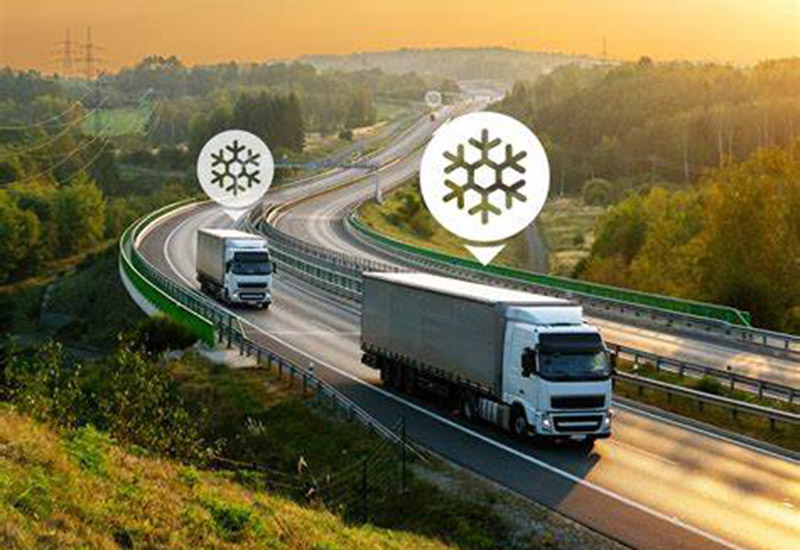The Role of GPS Trackers in Cold Chain Transportation: A Comprehensive Approach
The Role of GPS Trackers in Cold Chain Transportation: A Comprehensive Approach
Cold chain transportation, the process of shipping temperature-sensitive products, is critical in industries such as pharmaceuticals, food and beverages, and biotechnology. Ensuring the integrity of these products throughout their journey requires precise monitoring and control of environmental conditions. GPS trackers, integrated with temperature and humidity sensors, as well as door status recognition tools, provide a comprehensive solution to these challenges. This essay explores several real-world applications of GPS trackers in cold chain transportation, highlighting their impact on efficiency, product safety, and regulatory compliance.

Example 1: Pharmaceutical Transportation
A leading pharmaceutical company implemented GPS trackers equipped with temperature and humidity sensors in their cold chain logistics to transport vaccines and biologics. These products are highly sensitive to temperature fluctuations and require stringent conditions to maintain efficacy. The GPS trackers provided real-time data on the location of the shipments and continuously monitored the temperature and humidity levels inside the containers. Alerts were set up to notify the logistics team if any readings deviated from the acceptable range, allowing immediate corrective actions. This technology ensured the safe delivery of pharmaceuticals, minimized spoilage, and ensured compliance with regulatory standards, ultimately safeguarding patient health.
Example 2: Food and Beverage Industry
A large food distribution company utilized GPS trackers with integrated temperature and humidity sensors to transport perishable goods such as dairy products, meats, and fresh produce. During transit, these sensors continuously monitored the environmental conditions inside the refrigerated trucks. The GPS trackers also featured door status recognition tools that recorded every instance the truck doors were opened. This data helped ensure that the cold chain was maintained by minimizing exposure to external temperatures. By providing real-time alerts on any temperature excursions or unauthorized door openings, the company reduced spoilage rates, ensured food safety, and complied with food safety regulations.
Example 3: Biotechnology Sample Transport
A biotech firm specializing in genetic material transportation used GPS trackers with advanced environmental sensors to monitor the transport of DNA samples and other sensitive biological materials. Maintaining a stable environment was crucial to prevent degradation. The GPS trackers provided continuous updates on temperature, humidity, and the exact location of the shipments. The door status recognition feature ensured that samples were not compromised during loading and unloading processes. This comprehensive monitoring allowed the firm to guarantee the integrity of their samples, facilitating accurate research outcomes and fostering trust with their research partners.
Example 4: Organ Transplant Logistics
In the high-stakes field of organ transplantation, time and temperature control are critical. A healthcare logistics provider integrated GPS trackers with temperature and humidity sensors into their organ transport containers. These trackers ensured that organs were kept within the required temperature range from the point of donation to the point of transplantation. Additionally, door status recognition tools provided an extra layer of security, ensuring that the containers were only opened by authorized personnel in controlled environments. This technology reduced the risk of organ degradation, increased the success rates of transplants, and ultimately saved lives.
Example 5: Vaccine Distribution During COVID-19
During the COVID-19 pandemic, the rapid and safe distribution of vaccines required precise temperature control. A global logistics company employed GPS trackers with environmental sensors to monitor the transport of COVID-19 vaccines. The GPS trackers ensured that the vaccines were kept at the required ultra-low temperatures throughout the journey. Real-time data on location, temperature, and door status allowed for immediate response to any issues, ensuring the vaccines' potency upon arrival. This application was crucial in facilitating the widespread and efficient distribution of life-saving vaccines during a global health crisis.
Conclusion
The integration of GPS trackers with temperature and humidity sensors, along with door status recognition tools, has significantly enhanced the reliability and efficiency of cold chain transportation. These technologies provide real-time monitoring and alerts, ensuring the safe delivery of temperature-sensitive products across various industries. The examples provided illustrate the diverse applications and substantial benefits of GPS tracking technology in maintaining product integrity, ensuring regulatory compliance, and ultimately protecting consumer health and safety. As the demand for precise cold chain logistics continues to grow, the role of advanced GPS tracking systems will become increasingly vital in ensuring the successful delivery of sensitive goods.

